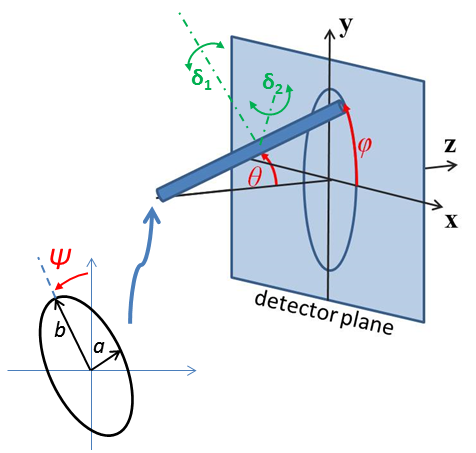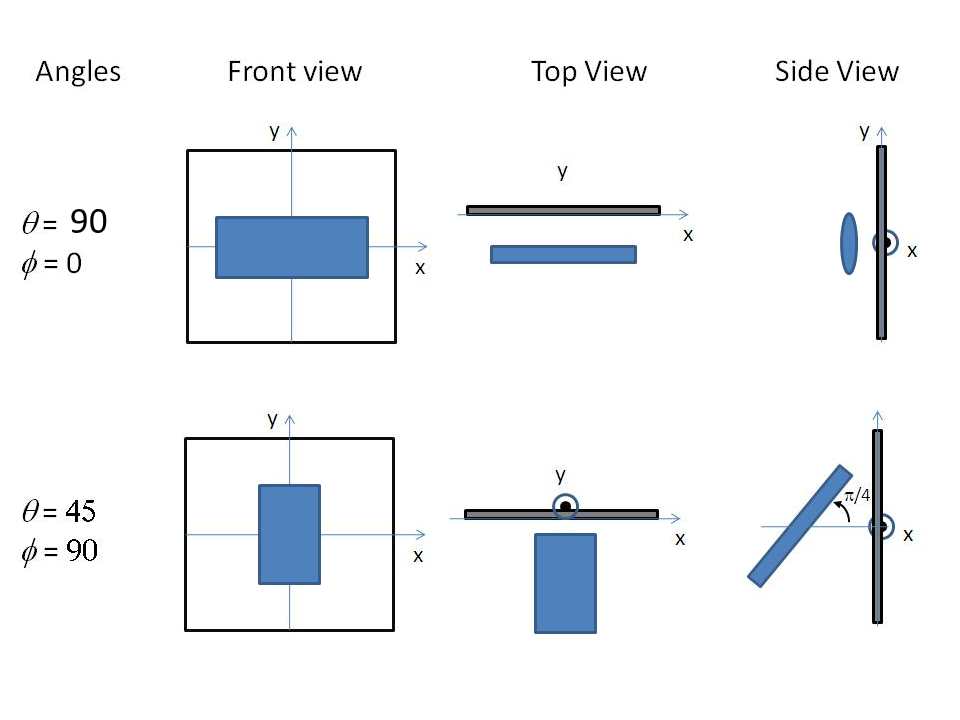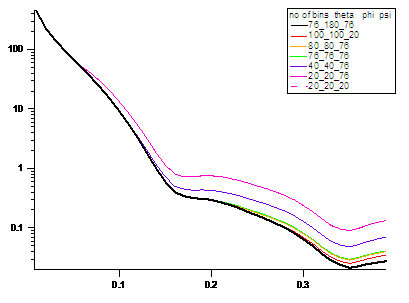elliptical_cylinder
Form factor for an elliptical cylinder.
| Parameter | Description | Units | Default value |
|---|---|---|---|
| scale | Scale factor or Volume fraction | None | 1 |
| background | Source background | cm-1 | 0.001 |
| radius_minor | Ellipse minor radius | Å | 20 |
| axis_ratio | Ratio of major radius over minor radius | None | 1.5 |
| length | Length of the cylinder | Å | 400 |
| sld | Cylinder scattering length density | 10-6Å-2 | 4 |
| sld_solvent | Solvent scattering length density | 10-6Å-2 | 1 |
| theta | cylinder axis to beam angle | degree | 90 |
| phi | rotation about beam | degree | 0 |
| psi | rotation about cylinder axis | degree | 0 |
The returned value is scaled to units of cm-1 sr-1, absolute scale.

Fig. 24 Elliptical cylinder geometry a=rminor and ν=rmajor/rminor is the axis_ratio.
The function calculated is
with the functions
where
and the angle ψ is defined as the orientation of the major axis of the ellipse with respect to the vector →q. The angle α is the angle between the axis of the cylinder and →q.
For 1D scattering, with no preferred orientation, the form factor is averaged over all possible orientations and normalized by the particle volume
For 2d data the orientation of the particle is required, described using a different set of angles as in the diagrams below, for further details of the calculation and angular dispersions see Oriented particles .

Fig. 25 Note that the angles here are not the same as in the equations for the scattering function. Rotation θ, initially in the xz plane, is carried out first, then rotation ϕ about the z axis, finally rotation Ψ is now around the axis of the cylinder. The neutron or X-ray beam is along the z axis.

Fig. 26 Examples of the angles for oriented elliptical cylinders against the detector plane, with Ψ = 0.
The θ and ϕ parameters to orient the cylinder only appear in the model when fitting 2d data.
NB: The 2nd virial coefficient of the cylinder is calculated based on the averaged radius (=√r2minor∗axis ratio) and length values, and used as the effective radius for S(Q) when P(Q)∗S(Q) is applied.
Validation
Validation of our code was done by comparing the output of the 1D calculation to the angular average of the output of the 2D calculation over all possible angles.
In the 2D average, more binning in the angle ϕ is necessary to get the proper result. The following figure shows the results of the averaging by varying the number of angular bins.

Fig. 27 The intensities averaged from 2D over different numbers of bins and angles.

Fig. 28 1D and 2D plots corresponding to the default parameters of the model.
Source
elliptical_cylinder.py
⋆ elliptical_cylinder.c
⋆ gauss76.c
⋆ sas_J1.c
⋆ polevl.c
References
- L A Feigin and D I Svergun, Structure Analysis by Small-Angle X-Ray and Neutron Scattering, Plenum, New York, (1987) [see table 3.4]
- Onsager, Ann. New York Acad. Sci., 51 (1949) 627-659
Authorship and Verification
- Author:
- Last Modified by:
- Last Reviewed by: Richard Heenan - corrected equation in docs Date: December 21, 2016